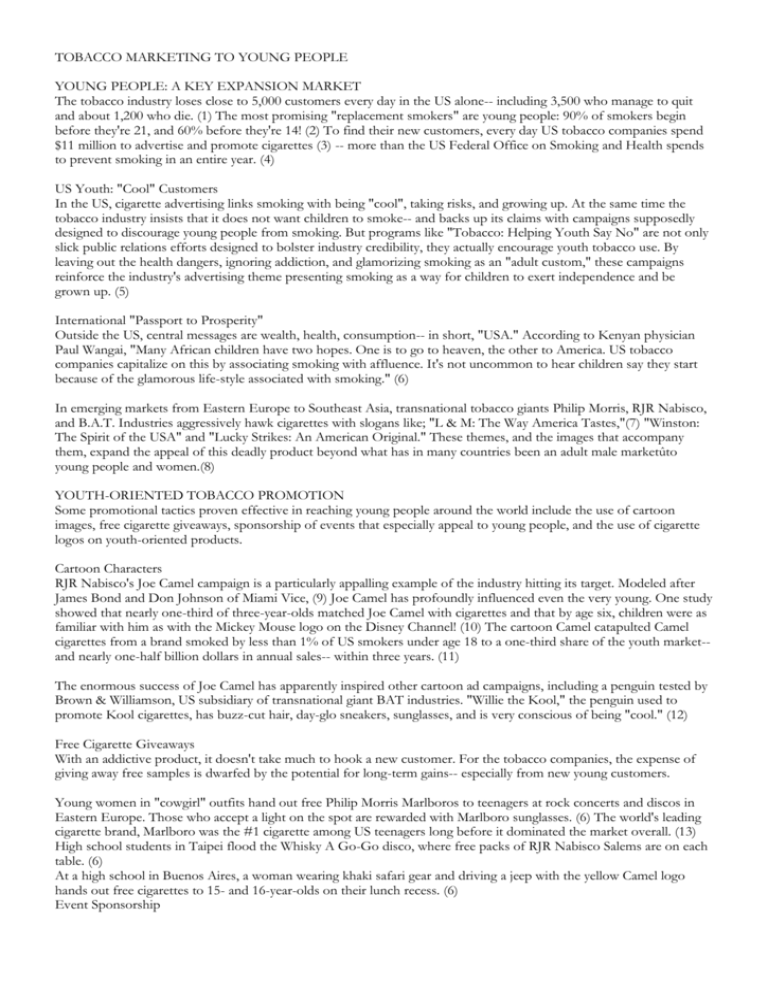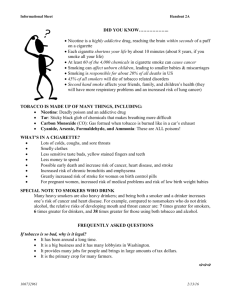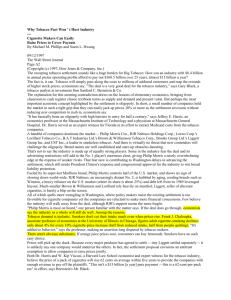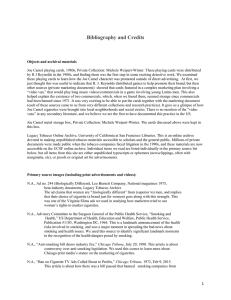tobacco marketing to young people
advertisement

TOBACCO MARKETING TO YOUNG PEOPLE YOUNG PEOPLE: A KEY EXPANSION MARKET The tobacco industry loses close to 5,000 customers every day in the US alone-- including 3,500 who manage to quit and about 1,200 who die. (1) The most promising "replacement smokers" are young people: 90% of smokers begin before they're 21, and 60% before they're 14! (2) To find their new customers, every day US tobacco companies spend $11 million to advertise and promote cigarettes (3) -- more than the US Federal Office on Smoking and Health spends to prevent smoking in an entire year. (4) US Youth: "Cool" Customers In the US, cigarette advertising links smoking with being "cool", taking risks, and growing up. At the same time the tobacco industry insists that it does not want children to smoke-- and backs up its claims with campaigns supposedly designed to discourage young people from smoking. But programs like "Tobacco: Helping Youth Say No" are not only slick public relations efforts designed to bolster industry credibility, they actually encourage youth tobacco use. By leaving out the health dangers, ignoring addiction, and glamorizing smoking as an "adult custom," these campaigns reinforce the industry's advertising theme presenting smoking as a way for children to exert independence and be grown up. (5) International "Passport to Prosperity" Outside the US, central messages are wealth, health, consumption-- in short, "USA." According to Kenyan physician Paul Wangai, "Many African children have two hopes. One is to go to heaven, the other to America. US tobacco companies capitalize on this by associating smoking with affluence. It's not uncommon to hear children say they start because of the glamorous life-style associated with smoking." (6) In emerging markets from Eastern Europe to Southeast Asia, transnational tobacco giants Philip Morris, RJR Nabisco, and B.A.T. Industries aggressively hawk cigarettes with slogans like; "L & M: The Way America Tastes,"(7) "Winston: The Spirit of the USA" and "Lucky Strikes: An American Original." These themes, and the images that accompany them, expand the appeal of this deadly product beyond what has in many countries been an adult male marketûto young people and women.(8) YOUTH-ORIENTED TOBACCO PROMOTION Some promotional tactics proven effective in reaching young people around the world include the use of cartoon images, free cigarette giveaways, sponsorship of events that especially appeal to young people, and the use of cigarette logos on youth-oriented products. Cartoon Characters RJR Nabisco's Joe Camel campaign is a particularly appalling example of the industry hitting its target. Modeled after James Bond and Don Johnson of Miami Vice, (9) Joe Camel has profoundly influenced even the very young. One study showed that nearly one-third of three-year-olds matched Joe Camel with cigarettes and that by age six, children were as familiar with him as with the Mickey Mouse logo on the Disney Channel! (10) The cartoon Camel catapulted Camel cigarettes from a brand smoked by less than 1% of US smokers under age 18 to a one-third share of the youth market-and nearly one-half billion dollars in annual sales-- within three years. (11) The enormous success of Joe Camel has apparently inspired other cartoon ad campaigns, including a penguin tested by Brown & Williamson, US subsidiary of transnational giant BAT industries. "Willie the Kool," the penguin used to promote Kool cigarettes, has buzz-cut hair, day-glo sneakers, sunglasses, and is very conscious of being "cool." (12) Free Cigarette Giveaways With an addictive product, it doesn't take much to hook a new customer. For the tobacco companies, the expense of giving away free samples is dwarfed by the potential for long-term gains-- especially from new young customers. Young women in "cowgirl" outfits hand out free Philip Morris Marlboros to teenagers at rock concerts and discos in Eastern Europe. Those who accept a light on the spot are rewarded with Marlboro sunglasses. (6) The world's leading cigarette brand, Marlboro was the #1 cigarette among US teenagers long before it dominated the market overall. (13) High school students in Taipei flood the Whisky A Go-Go disco, where free packs of RJR Nabisco Salems are on each table. (6) At a high school in Buenos Aires, a woman wearing khaki safari gear and driving a jeep with the yellow Camel logo hands out free cigarettes to 15- and 16-year-olds on their lunch recess. (6) Event Sponsorship Tobacco companies gain widespread exposure for their brands and associate their deadly products with positive experiences by sponsoring a wide variety of events around the world. Rock concerts and sporting events in particular reach large audiences of young people. Rock Concerts: Rock concerts, with their celebrity starts, Western image, and enormous following of young fans, have been a magnet for tobacco industry sponsorship outside the US. In countries where cigarette advertising is banned or restricted, sponsoring live or televised concerts enables the companies to get around local regulations. In Taiwan, RJR Nabisco agents arranged a concert by teen idol Hsow-Yu Chang, with five empty packs of Winstons the only accepted admission "ticket"-- ten for a souvenir sweatshirt. (14) Among the performances sponsored by RJR's Salem were a live concert by Paula Abdul in Seoul, (6) and a televised concert by Madonna in Hong Kong-- where TV ads for tobacco are banned. Also in Hong Kong, Philip Morris sponsored the Marlboro Rock-In, a series of televised concerts. (12) Sporting Events: Sports sponsorship is especially insidious, because it implies that smoking and fitness mix. Young people seeing cigarette logos linked with their heroes, excitement, speed and triumph are likely to lose sight of the reality of death, disease and addiction. In the US, companies receive valuable television air time by sponsoring sports, and evade the federal ban on television advertising of tobacco. Philip Morris's Virginia Slims tennis and RJR Nabisco's Winston Cup auto racing were both launched in 1971-- the same year the federal law barring cigarette ads from television and radio took effect. (15) During the 1989 Indianapolis 500, Marlboro received over $2.6 million worth of advertising exposure. (16) Walking Billboards: Cigarette-Branded Merchandise Another clever way to keep cigarette brands constantly in the public eye and circumvent restrictions on advertising is known as "brand stretching"-- using cigarette logos on other products. Many of these products are fun and fashionable for children in the US and around the world, who become walking billboards for tobacco. US promotions in particular often have the added danger of rewarding cigarette consumption by offering merchandise in exchange for coupons from cigarette packs. RJR built on the Joe Camel campaign in 1991 with the "Camel Cash" promotion, offering coupons resembling onedollar bills in every pack of filtered Camel cigarettes. These "Camel C-notes" picture Joe Camel, in sunglasses and smoking, dressed as George Washington. Consumers can redeem Camel Cash for "smooth stuff" with obvious appeal to young people-- "flip-flops," insulators for beverage cans, jackets, towels, T-shirts, and hats-- all featuring Joe Camel. (12) Philip Morris offers nine items, including black leather backpacks, a tough biker jacket, sunglasses, and vests, in its new Virginia Slims "V-Wear" line. According to a Philip Morris marketing vice president, "Fashion has always been an element with Virginia Slims." (17) Children are given Marlboro T-shirts in Kenya, and Marlboro clothing in Guatemala. (14) In Thailand, cigarette logos have appeared on kites, T-shirts, pants, notebooks, earrings, and chewing gum packages. (14) In Kuala Lumpur, Malaysia, a record store called the Salem Power Station wraps customers' tapes in advertisements for Salem cigarettes. Nearby, a Camel Adventure Gear store sells Camel brand products. (12) THE RESULTS: YOUTH SMOKING ON THE RISE In the US: After declining every year for 25 years, US smoking rates increased slightly in 1991 (18) -- reflecting the tobacco industry's success at hooking young smokers. More than 3,000 US teens become regular smokers each day (2) , with girls smoking at a higher rate than boys. (19) Since RJR's Joe Camel campaign began, smoking among US teens is up 10%. (20) US teenagers buy the most heavily promoted cigarettes, and 80% of teens consider advertising influential in encouraging them to begin to smoke. (21) The tobacco industry began aggressively targeting women with Philip Morris's introduction of Virginia Slims in 1968. Within six years, the number of teenager girls smoking more than doubled. (22) Around the World: Transnational tobacco companies such as Philip Morris, RJR Nabisco, BAT Industries, and American Brands are also making their presence felt in other countries. In the developing world, per capita cigarette consumption has risen on average by more than 70% during the last 25 years. (23) Hong Kong children as young as seven years old are addicted to cigarettes. (12) The teen smoking rate in some Latin American cities is 50%. (6) In Kenya, the smoking rate among primary school children was estimated at 40% in 1989-- a huge jump from the 10% level estimated a decade earlier. (12) Smoking rates among male Korean teenagers rose from 18% to 30% in one year after the entry of US tobacco companies. Among female teenagers rates increased from less than 2% to nearly 9%. (24) Sources INFACT's Tobacco Industry Campaign






